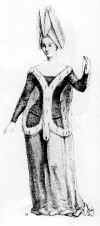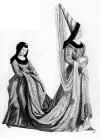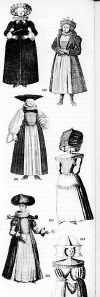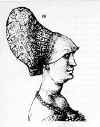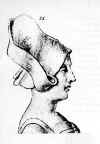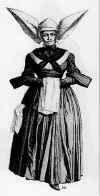|
|
|
|
|
|
|
|
|
|
| Medieval
Research:
Women’s Hats
|
|
|
|
The Hennin: ...whatever the reason for the beginning of the fashion, it soon developed into a display of status...
Click here
for other groups from the Middle ages who wore tall pointy hats. |
During
the Middle Ages, there were changes, which came about in the clothing of
both the men and the women.
The church frowned on the form-revealing gown with open sides for women, and the emphasis became the matronly look. Perhaps, the women holding up the long front of the gown by the material on the stomach added to this look. http://www.nationalgallery.org.uk/WebMedia/Images/18/NG186/eNG186.jpg Some of these changes during medieval times had to do with the availability of fabrics from other lands, because of the Crusades. Items brought back which were new to the northern Europeans included Damask from Damascus and gauze from Gaza. Maybe it is because of the emphasis on modesty that the dress doesn't change much at all, after becoming less form fitting. Perhaps this is why women began to use the headdress to draw attention to themselves. But, whatever the reason for the beginning of the fashion, it soon developed into a display of status. The headdress referred to as the hennin became popular. One could still cover at least most of the hair, if she was careful to pluck the forehead first! Perhaps there was some practical value, as the castles were very draughty, and one could at least keep her ears warm! www.virtue.to/articles/images/1449_elegius.jpg And of course the poorer people could not afford to wear something so impractical! I can imagine one of the more outrageous versions catching on the rafters of one's hovel!! I was very grateful to find a site by Cynthia Virtue with many portraits and pictures showing examples of the types of headdresses worn. www.virtue.to/articles/heart_notes.html Most of the extreme versions of the hennin can be found from paintings of women in the 1400's. But, there are some instances of a similar type of hat worn before that. Braun & Schneider's drawings from c.1861-1880 show a pointy hat on a Norman noblewoman. www.siue.edu/COSTUMES/PLATE14CX.HTML and a heart shaped headdress from the 14th century www.siue.edu/COSTUMES/PLATE22CX.HTML On her great website, Cynthia Virtue has also researched the progression of the styles of the hennin. www.virtue.to/articles/arnolfini.html Braun & Schneider's drawings from c.1861-1880 also show some of these examples. www.siue.edu/COSTUMES/PLATE24AX.HTML www.siue.edu/COSTUMES/PLATE27AX.HTML www.siue.edu/COSTUMES/PLATE27CX.HTML www.siue.edu/COSTUMES/PLATE28DX.HTML www.siue.edu/COSTUMES/PLATE31BX.HTML There are some very good opportunities of looking at the hats and costumes of people in the 1400's if you follow this link. http://marquise.de/en/1400/pics/index.shtml
|
Drawings on this
page are from
the book by Fabre.
I have found some images of unusual hats from this era in the book
History of Fashion by Maurice Fabre. According to Fabre, “the hennin is
so called because a certain Some of the drawings from the book are below.
|
| The church really frowned on this type of headdress. Comments included references to the "horns of the devil"! | The popularity of the hennin seemed to decrease as Europe became more stable. In England, as the Tudor Period brought internal fighting to a close, the hats became shorter, and developed into the firm gable headdress. I do wonder if the hennin style headdress was something used by women to redirect their men’s attention from going to war... either that, or to keep them occupied while the men were away! | |
